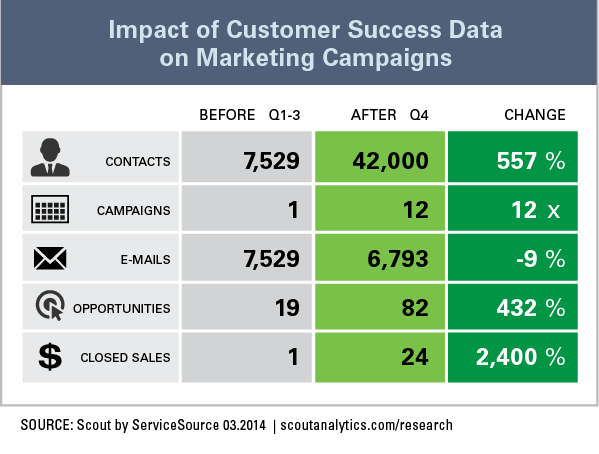You might not normally consider customer success when you’re thinking about marketing—but in the subscription economy, customer success can be critical to making marketing campaigns more effective.
Why? The short answer is that customer success data can help you lower your cost per lead and increase your number of opportunities—and we’ve watched as one company has used customer success data to grow its closed opportunities by 2,400%.
More on that example shortly, but first let’s examine the theory behind the data: In the subscription economy, sustained growth is not based on customer acquisition—it’s based on maximizing customer lifetime value. This means that to grow, you must effectively market up-sells and cross-sells to the right customers at the right time.
This is where customer success can have a substantial impact. Customer success tracks and manages on-boarding, adoption, and value creation, while at the same time building a rich database that can be used to improve marketing campaigns.
Customer success provides three specific leverage points to improve marketing. Customer success can:
- Increase marketable contacts (i.e., customers/influencers you can reach)
- Increase the number of campaigns
- Increase conversion rates
What marketer wouldn’t want that from their customer success team?
So how do you make it happen? Let’s look at our example: The company in question provides a financial SaaS application. The product line has twelve different products, but the majority of customers only own one product. To grow customer lifetime value, the company’s goal is to sell the next best offer to existing customers.
Prior to using customer success data to inform its marketing campaigns, the company executed one campaign per quarter. The contacts included in the campaign had been collected during the customer acquisition and deployment process, and they were mainly project managers and purchase decision-makers. The campaigns were targeted to the entire customer base, with whatever offer was considered to have the broadest appeal.
Before making any changes, these were the average results across the previous three quarters:
- 7,529 emails sent
- 19 opportunities generated
- 1 opportunity closed
The next quarter, the SaaS provider decided to use customer success data—including user contact details and usage data—to inform and improve the marketing campaigns.
With this new customer success data, the marketing team could completely change their contact list, strategy, and segmentation: First, users became contacts in the marketing database, expanding the marketable records from about 7,500 to over 40,000. Second, rather than running one campaign for everyone, they created twelve campaigns that could be targeted based on actual customer usage. Third, rather than run the campaigns on a specific date, contacts were added to campaigns based on usage events, which improved timeliness.
The results were dramatic:
- 6,793 emails sent (a 9% decrease)
- 82 opportunities generated (a 432% increase)
- 24 opportunities closed (a 2,400% increase)
Note that the number of emails sent actually went down—which equates to a better customer experience, a key charter of customer success. And this better customer experience was borne out by the campaign results: over 4x the opportunities and 24x the closed deals.
In other words, the company provided more relevant and valuable offers to the right customers at the right time. The following graphic summarizes the impact.

The Implication
By including users as contacts in the marketing database, the company was able to include more influencers in the buying decision. By promoting an offer based on usage, the company was able to understand who might be “in market” and open to an offer. This is similar to behaviorally targeted digital advertising, which typically has 3x the response rate of simple display advertising—but in this case, they saw a 24x higher conversion rate.
Customer success and marketing are made for each other. Your marketing gets more productive with data from customer success—and your customers get more value with the right marketing.






